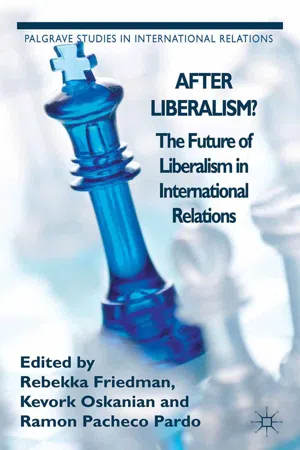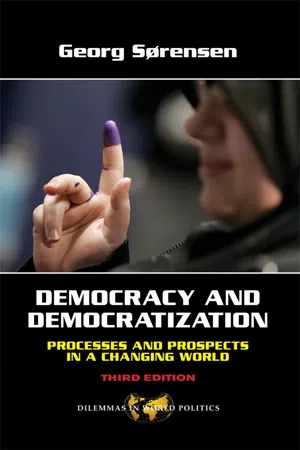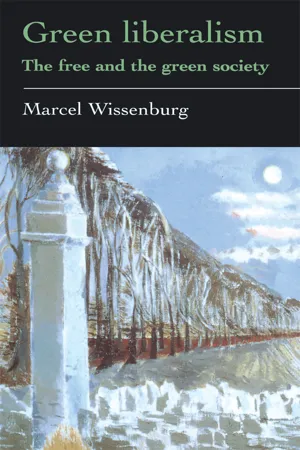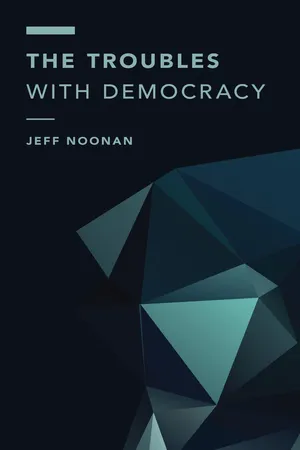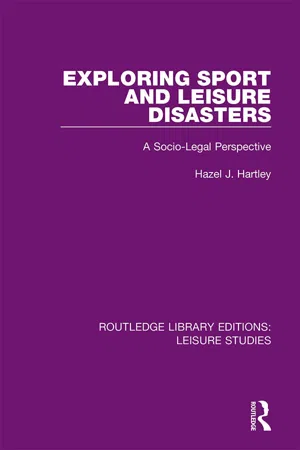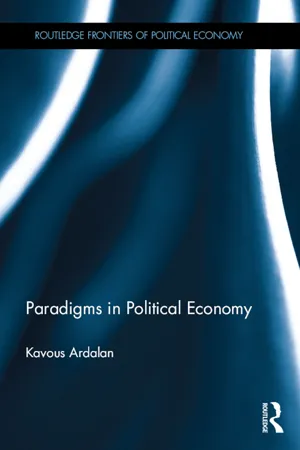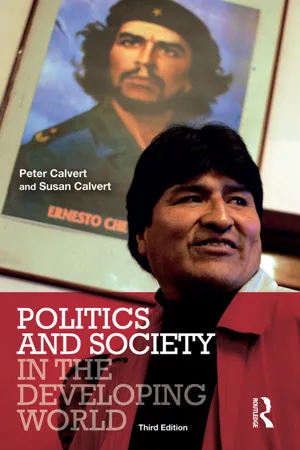Politics & International Relations
Liberal Democracy
Liberal democracy is a form of government characterized by the protection of individual rights and freedoms, the rule of law, and a system of checks and balances on power. It emphasizes the importance of free and fair elections, political pluralism, and the protection of minority rights. Liberal democracies typically have a constitution that limits the powers of the government and protects the rights of citizens.
Written by Perlego with AI-assistance
Related key terms
11 Key excerpts on "Liberal Democracy"
- eBook - ePub
After Liberalism?
The Future of Liberalism in International Relations
- R. Friedman, K. Oskanian, R. Pachedo Pardo, R. Friedman, K. Oskanian, R. Pachedo Pardo, Kenneth A. Loparo, R. Friedman, K. Oskanian, R. Pachedo Pardo, Ramon Pacheco Pardo(Authors)
- 2013(Publication Date)
- Palgrave Macmillan(Publisher)
All citizens in such country have a right to, and are not restricted in practice from, fully exercising such fundamental freedoms as the freedom of expression, conscience, and peaceful assembly and association, and such country has a free, independent, and pluralistic media.(E) The current government of such country did not come to power in a manner contrary to the rule of law. (F) Such country possesses an independent judiciary and the government of such country generally respects the rule of law. (G)Such country does not violate other core principles enshrined in the United Nations Charter, the Universal Declaration of Human Rights, the International Covenant on Civil and Political Rights, United Nations Commission on Human Rights Resolution 1499/57 [sic; should be 1999/57] (entitled “Promotion of the Right to Democracy”), and the United Nations General Assembly Resolution 55/96 (entitled “Promoting and consolidating democracy”).(H)As applicable, whether the country has scored favourably on the political, civil liberties, corruption, and rule of law indicators used to determine eligibility for financial assistance disbursed from the Millennium Challenge Account.(H.R. 982 (110th): Advance Democracy Act of 2007)The characteristics noted by the United States would clearly qualify as Liberal Democracy and, read by themselves, would not support the contention that the international order has entered a post-liberal phase. They also demonstrate, however, that declarations of democracy alone and even guarantees of “free and fair elections” are not sufficient to secure liberalism’s future.International law or international standard?From the foregoing, it is probably fair to characterise much of the activity surrounding the creation of a democracy norm as one of setting standards. What has emerged is an understanding that claims to democracy cannot mean merely what any state claims they should mean. Democracy is gaining a determinate meaning, and setting a certain standard for what it means to be a democracy. That standard is regular elections where at least two competing political parties are allowed freely to petition votes and where electoral processes are not interfered with to the point of distorting, much less overthrowing voter preferences. Human rights petitioners would like that standard to go much further, of course, and to guarantee the full panoply of political rights; such as for example equal rights to media access and the disqualification of elections where any - eBook - ePub
Democracy and Democratization
Processes and Prospects in a Changing World, Third Edition
- Georg Sorensen(Author)
- 2018(Publication Date)
- Routledge(Publisher)
5 In other words, what is the appropriate liberal democratic balance between competing values? Is such a balance even possible?In more recent times, the process of democratization is happening in many different places around the world, even as globalization and other forces are bringing countries closer together. These developments have sparked new debates about the economic, cultural, and social conditions under which democracy can develop, and about the consequences of globalization for democracy.Rather than presenting all these debates in detail, I shall identify concepts of the core features of democracy in the modern sense and point out the main areas where these concepts are still debated.Liberal Democracy and its Critics
Liberalism developed in opposition to medieval hierarchical institutions, the despotic monarchies whose claim to all-powerful rule rested on an assertion of divine support. Liberalism attacked the old system on two fronts. First, the liberalists fought for a rollback of state power and the creation of a sphere of civil society where social relations, including private business, nonstate institutions, family, and personal life, could evolve without state interference. “Gradually, liberalism became associated with the doctrine that individuals should be free to pursue their own preferences in religious, economic and political affairs—in fact, in most matters that affected daily life.”6 An important element in this regard was the support of a market economy based on respect for private property.The second element of early liberalism was the claim that state power was based not on natural or supernatural rights but on the will of the sovereign people. Ultimately this claim would lead to demands for democracy—the creation of mechanisms of representation that ensured that those who held state power enjoyed popular support. Yet the creation of such mechanisms was not a primary concern of early liberalism. The tradition that became Liberal Democracy was liberal first (aimed at restricting state power over civil society) and democratic later (aimed at creating structures that would secure a popular mandate for holders of state power). Yet liberals had reservations about democracy, fearing that it would impede the establishment of a liberal society.7 - eBook - ePub
Green Liberalism
The Free And The Green Society
- Marcel Wissenburg(Author)
- 2013(Publication Date)
- Routledge(Publisher)
1Liberal Democracy
1.1 Introduction
Since it is my intention to design a ‘green’ liberalism, a liberal democratic view on nature, the environment and environmental problems, the first thing to ask is: where to start? What precisely is Liberal Democracy about? The aim of this chapter is to develop a relatively formal model of criteria of Liberal Democracy. The criteria I formulate define a stringent but minimal version of Liberal Democracy; stringent in that the conditions are quite strict, but minimal in the sense that adapting them would either change nothing about our conclusions or would disfigure Liberal Democracy beyond recognition.The first thing to note about Liberal Democracy is that it can be represented, like (to some degree) any other political system, as a system designed to translate preferences into rights. More precisely: it can be represented as the existence, on a collective level, of mediating and reconciliatory mechanisms (state, market, education, etc.), transforming the claims of individuals to benefits and the reduction of burdens into formal rights via the recognition of valid claims by means of principles of social justice. Claims can be seen as based on preferences and metadesires, and these in turn are intrinsically related to the individuals’ plans of life and views of the good. Despite the diversity of conceptions of the good life we may assume the existence of a rough consensus on the need for these mechanisms – that is, a rough consensus on the institutions defining Liberal Democracy.This is, obviously, a very one-dimensional view of Liberal Democracy and of politics in general. In real life, the decisions to translate some preferences of some citizens for, say, the conservation of a forest into a specific type of right for all, i.e. the obligation not to destroy the forest, in fact shapes or rearranges preferences. In this case, the lives, possibilities and perspectives of building constructors, businessmen and women, investors, nature lovers etc. are changed, hence their respective sets of (feasible) preferences are altered. Ideally, even the public debate on whether or not to protect a forest can change preferences: opponents may actually convince one another of their views or influence them just enough to build a compromise. In short, it is not realistic to take preferences as a given. Yet this is precisely what I shall do, for the most part. - eBook - ePub
- Brett Bowden, Leonard Seabrooke(Authors)
- 2006(Publication Date)
- Routledge(Publisher)
This last point brings us back to my earlier observation that liberalism should be seen as a governmental project, developing initially within the conditions provided by the European system of states. If the Westphalian system addressed the problem of pacifying warring populations by assigning those populations to the exclusive rule of discrete sovereign states, this did not entirely resolve and may even have exacerbated the related problem of pacifying rulers themselves. Indeed, the problem of civilizing states was a major concern of eighteenth-century political thought, and it has remained a central theme in liberal discussions of international order ever since. In this respect, Rawls’s (1999) account of liberalism as primarily a matter of intra-state relations, which presents liberal discussion of international order as a derivative, secondary development, is seriously misleading. Liberalism is more properly seen as a positive project of government, concerned with governing the larger human population covered by the system of states. It has addressed this problem not only by incorporating humanity within the modern system of states, as the regimes of modern imperialism and post-colonial independence have each done in their own way, but also by using market interactions and other devices to civilize and to regulate the conduct of states themselves and the particular populations under their authority.A standard of citizenship and democracy
How does this sketch of the liberal project of government relate to the contemporary standard of citizenship and democracy? I began this chapter by noting that, in order to understand the place of citizenship and democracy in the modern world, it is necessary to locate them as elements within a supra-national governmental regime. I then suggested that the sovereignty of states should be seen as an artifact of the system of states, and thus that it is misleading to regard states as constituted essentially on the basis of formal or informal agreements among their citizens. This means that the government of a state is never simply a matter of internal relations between the state and its own citizens or subjects, however democratic it might appear to be.The suggestion that modern democratic states are not really controlled by their citizens is hardly new. Many commentators have argued that the institutions of representative government ensure that citizens play a strictly circumscribed role in the government of the state to which they belong (Hindess 2000 ). This is the substantive empirical foundation of the ‘realist’ theory of democracy, one of the most influential doctrines in twentieth-century political science (the classic account is Schumpeter 1976; Sartori 1987 - eBook - ePub
- Jeff Noonan(Author)
- 2019(Publication Date)
- Rowman & Littlefield International(Publisher)
Chapter 2 Liberalism and DemocracyThe classical liberal principles of equality, individual rights, consent to government, and the rule of law are typically understood as synonymous with democracy. Despite this assumed synonymy, I will argue that there are fundamental tensions between the democratic value of collective self-determination and the classical liberal interpretation of individual rights and liberty. From the democratic perspective, self-determination is first of all a shared achievement that depends on collective control over universally required life-resources and their use in life-sustaining and enhancing ways. In liberalism, on the contrary, individuals are abstracted from the social whole and rights institutionalized in ways that contradict collective self-determination. In practice, historically, the liberal opposition between collective self-determination and the right to private property has meant the subordination of the democratic power of the whole to the economic power of the class that controls universally required resources and institutions.This tension marks the development of liberalism on the international scale as well. As Beate Jahn has shown, as far back as Locke, a complex dialectic of national development and colonial domination shaped the emergence of liberal-democratic capitalist societies. “Colonialism,” Jahn notes, “played a crucial role for economic development in Europe. . . . It allowed the domestic poor and politically disenfranchised to emigrate and thus relieved the political pressure on the government. And it allowed the government to export its poor . . . [and] provided common political ground for rich and poor alike.”1 The common ground was an alliance against the indigenous population now subordinate to colonial power. The internationalization of liberal-democracy, therefore, intensifies rather than solves its domestic contradictions.These tensions have left liberalism susceptible to change through democratic struggles. The complex history of liberalism from the late seventeenth century until today is a series of theoretical and practical attempts to coherently synthesize the democratic implications of its understanding of equality with the undemocratic implications of its understanding of liberty. The results have been uneven. It would be ahistorical to argue that liberalism is completely undemocratic. It is obvious that part of what oppressed groups have fought for are inclusive interpretations of the political and civil rights denied them. Moreover, while democracy requires that people have determining power over the major social institutions that shape their life-horizons, this principle is not incompatible with representative institutions. People cannot be constantly engaged in political deliberations and still have time for other meaningful forms of self-realization. Finally, to say that individual self-determination is not a property of abstract individuals but an achievement of democratic social organization is not to say there should be no private sphere of life. The democratic goal is not to abolish privacy and individuality, but rather to ensure that both take forms that cohere with the general demands of environmental integrity, social peace, and universal flourishing. - eBook - ePub
Exploring Sport and Leisure Disasters
A Socio-Legal Perspective
- Hazel J. Hartley(Author)
- 2019(Publication Date)
- Routledge(Publisher)
CHAPTER 2Liberal Democracy, THE STATE AND THE RULE OF LAW
INTRODUCTION
Giddens (1992, p 330) regards the association with democracy as one of ‘the most important aspects of the modern state’. Democracy is derived from demokratia, the root meanings of which are demos (people) and kratos (rule) and is ‘a form of government in which, in contradistinction to monarchies or aristocracies, the people rule’ (Held, 1987, p 2). There is a history of conflicting conceptions of the term and in articulating each element – the rule, rule by and the people.According to Held (1987, p 3) this relates to determining whether democracy will mean some kind of popular power involving self-government, ‘an aid to decision-making’, which will reflect the decisions of those elected. Held (1987, p 4) divides contemporary models of democracy into two broad types: a direct or participatory democracy, where citizens are directly involved in decisions and a liberal or representative democracy. The latter is a system of rule embracing elected officers who undertake to represent the interests of and or views of citizens, within a framework of the rule of law.A liberal democratic state assumes a clear separation between the law-makers (government executive) and those who apply the law (judiciary) and a legitimacy, the belief that a particular political order is just and valid, and the production of consent for government policies and laws is geared towards the management of conflict (Scraton, 1985). A Liberal Democracy has at its centre the notion of pluralism, which depends on the ‘role of diverse and competing interest groups’. Such groups each have ‘the same impact on policy but none dominating the actual mechanisms of government’ (Giddens, 1992, pp 335, 759).Multiple and competing interest groups diversify power, process consent, influence policy and avoid too much power being appropriated by one group or the Government. This theoretical stance of pluralism suggests that such groups place crucial obstacles in the way of excessively powerful factions and an unresponsive state, including a series of checks and balances between the legislature, executive, judiciary and administrative bureaucracy (Held, 1987, p 204): - Peter Joyce(Author)
- 2015(Publication Date)
- Teach Yourself(Publisher)
2 Liberal DemocracyPolitical systemsIn this chapter we will consider the liberal democratic political system. This is the system mostly used in the Western World and the one we are most familiar with. We will identify the key features of the system and, in particular, will consider the mechanisms through which the wishes of the majority of the population are able to influence the operations of government and the conduct of the legislature.Key idea (1) There are a wide variety of political systems throughout the world. These consist of ‘liberal democratic’, ‘communist’, ‘totalitarian’ and ‘oligarchic’ political systems. These systems are distinguished from one another by a process of differentiation termed classification.A political system is the constitutional framework through which demands are put forward and decisions are made. It has no physical dimension or formal existence, but consists of the institutions, processes and relationships involved in the process of agenda setting, policy formulation and decision making. These include the formal institutions of government and informal agencies such as the media.Political systems are distinguished from each other in a number of ways. The process of differentiation is termed ‘classification’. There are four broad types of political systems – liberal democratic, communist, totalitarian and oligarchic. The extent of civil rights in liberal democratic systems facilitates a wider degree of public participation in political affairs than is permitted in the other two systems.In liberal democratic political systems, members of the general public may secure involvement in policy making through mechanisms that allow them to express their views to the policy makers on particular issues. Consultation implies the right to be heard. Citizens may be invited to express their opinions on particular matters to which the policy makers listen, but are not required to act on. Participation, however, involves a shift in the power relationship between policy makers and the public. Policy making is transformed into a joint exercise involving governors and the governed.- eBook - ePub
- Kavous Ardalan(Author)
- 2015(Publication Date)
- Routledge(Publisher)
3It may be argued that there are three concepts of democracy, each one shapes and is shaped by a particular kind of society at a particular time. Liberal Democracy serves the needs of the competitive market society. Liberal Democracy is the product of the liberal market society. In the first place, the market society needed a liberal state, not a democratic one. A liberal state operates by competition among political parties that are responsible to a nondemocratic electorate. The liberal state became the liberal democratic state after the working-class that was produced by the capitalist market society became strong enough to demand participation in the competitive process. Therefore, Liberal Democracy is the product of the development of the capitalist market societies.The other two concepts of democracy are nonliberal democracies. Both of them are closer to the original notion of democracy, that is, the rule by and for the poor and oppressed, which is not liberal at all. The communist concept of democracy takes the original notion and fits it into specific class content and a specific time scheme. That is, democracy means the rule by and for the proletariat. It is a class state, created by proletarian revolution, keeps under control the old ruling class, and transforms society such that there are no more bases for exploitive classes and there is no more need for a class state. In this way class democracy gives way to a fully human society.The third concept of democracy, which is neither liberal nor communist, prevails in the newly independent underdeveloped countries. It rejects the notion of competition both in the market economy and the political system. It advocates the one-party state, but rejects the communist idea that when people break away from capitalism the post-revolutionary state has to be a class state. It believes in operating immediately as a classless society and state. That is, democracy is the rule by the general will, which starts when national independence is attained. - eBook - ePub
Can Democracy Be Saved?
Participation, Deliberation and Social Movements
- Donatella della Porta(Author)
- 2013(Publication Date)
- Polity(Publisher)
relative and cannot exceed certain boundaries’ that are defined in the ‘compromise agreement which recognizes the collectively accepted rules for the peaceful resolution of conflicts between social, politically represented and significant parties’ (Morlino 2011, 30–1).Similarly, in what has been called the genetic definition of democracy, democracy is considered as that bundle of norms and procedures that derive from a compromise oriented to the peaceful solution of the tensions that emerge among relevant actors in a specific political system (for example, Przeworski 1991, 26–34).Even if we speak of competition (above all between parties) and of majority and opposition, the liberal conception of democracy is founded on the recognition of individual rights, while conflicts between collective actors tend to be considered as pathological. Citizens with a base of similar values, interested principally in their own material wellbeing, have the power to decide between political leaders in constant competition amongst each other. Indeed, the need for generally shared values is often affirmed, even if there are ever-increasing doubts as to the real extent to which these are shared in contemporary democracies (Held 1997). As David Held observes, in this competitive elitism, ‘the sole role of the elector is to accept or reject one boss over another. The boss guarantees order and the capacity to manage the complexity of the political world; the vote of the electorate supplies legitimacy to subsequent political action’ (1997, 265). Competition must however be limited on some themes. As summed up by David Held, ‘the competition between rival leaders and parties must regard a relatively limited range of political questions: these must be reciprocally bound by consensus on the overall orientation of national politics, on a reasonable parliamentary programme and on general constitutional business’ (1997, 266). - eBook - ePub
Democracies in Peril?
Waves of Backsliding
- Hans Keman(Author)
- 2023(Publication Date)
- Routledge(Publisher)
Eventually, these ideas were institutionalised in (individual) freedoms 1 and assigning the judiciary to oversee their maintenance. Hence, civil and political rights that were gradually granted to the citizens are today considered as a cornerstone of a democratic polity. These ideas were embodied in the work of, for example, J.S. Mill (see Chapter 4.3), and is concisely rendered as follows by Lord Bryce in his study of “modern” democracies in 1921: “Democracy is supposed to be the product and guardian both of Equality and Liberty, being so consecrated by its relationship to both these precious possessions as to be almost above criticism” (Bryce, 1921 : 24). This illustration of what the “liberal” version of democracy is, and which has conquered the world became after the Second World War the yardstick to measure the level of democraticness worldwide. The individual rights of the citizen are central to judging the quality of the polity. Probably the research institute Freedom House is the core example of this persuasion. The pivotal point in their operationalisation is that political and civil rights ought to be considered as essential to enjoying democracy. The presence of such rights and their effective maintenance would be indicative of a free society and protection against abuse from the state. States not meeting these criteria are seen as undemocratic and divide the world into “good” guys and “bad” fellows. Obviously, this approach is typical for the ideological contest during the Cold War between the “East and West” that dominated the post-war international relations up to the decline and disintegration of the USSR after 1989 (Sakwa, 2021). However, such an approach is too limited to assess the democratic quality. Equality and Liberty per se are not denounced by critics but rather the liberal mode of inclusion, decision-making and keeping the state powers in check are absent - eBook - ePub
- Peter Calvert, Susan Calvert(Authors)
- 2014(Publication Date)
- Routledge(Publisher)
Liberal Democracy is well established in Western Europe, North America, Japan and other AICs, and in only a small number as yet of the many developing countries. However, economic development is not a prerequisite for people to want democracy, as is demonstrated by the persistent reappearance of the liberal tradition in Latin America over the past century and a half, and some striking examples from South Asia, the Middle East and the Caribbean. Liberal Democracy has proved adaptable and responsive to the pressures of survival in a competitive world, and with the collapse of the rival Soviet model, it currently has no effective competitor. This does not mean that all liberal democracies are the same. All states, even liberal democracies, exist in an evolutionary context and may well have diverged considerably from the ideal types they profess to represent (cf. Macpherson 1977). Moreover, on many occasions rulers have already argued that for reasons of national sec8urity, or otherwise, they have found it ‘necessary’ to suspend or dispense with any or all of the notions of individual rights, limitation of government power or the right to a fair trial.Empowerment and the growth of civil society
Since the nineteenth century, it has been a widespread assumption, particularly in English-speaking countries, that stable democratic systems required a high level of social consensus. Where this was achieved, political stability was enhanced and society unified. Where it was not, there was a tendency for political order to break down and democracy to collapse. For some time it has been accepted that the key determinant of political stability is the number and nature of social cleavages in society (Lipset and Rokkan 1967; Rae and Taylor 1970; Lane and Ersson 1991). There are many factors dividing groups in all societies. If the dividing lines between these groups do not coincide with each other, competitive democratic politics can and does take place without endangering the whole structure. The problem comes when they do coincide with one another and a major split opens up.However, there are several states which are among the most democratic in Europe in which, on the contrary, a high level of agreement is obtained in divided societies. Hence special interest attaches to what is now termed consociational democracy
Index pages curate the most relevant extracts from our library of academic textbooks. They’ve been created using an in-house natural language model (NLM), each adding context and meaning to key research topics.
